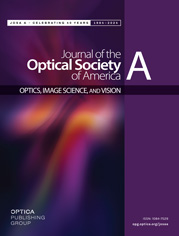JOSA A Feature Issue
Single Molecule Image Formation, Reconstruction and Processing
Submission Opens: 30 November 2015
Submission Deadline: 15 February 2016
The ability to image single molecules has revolutionized research in molecular biology. Unraveling the structure and function of the basic molecular building blocks of life is greatly aided by nano-scale imaging. This can be done in a dynamic mode by tracking sparse single molecules performing their function inside the cell as well as in a static mode by assembling a super-resolution image from single molecule localizations. The sparse distribution of single molecule images in the raw images is realized by stochastic on-off switching of the fluorescence of the molecules. The localization precision is primarily limited by the shot noise related to the small number of collected photons per localization event but can be as low as 10 nm.
Single molecule imaging rests on three pillars: (1) the biochemistry of fluorescent labeling optimized for biological specificity, photon production, and stochastic switching; (2) the optical microscopy setup with focus on low-noise imagers such as EM-CCDs, stability during image acquisition, optical quality, and collection efficiency; (3) the image processing and analysis chain to extract the single molecule position and other data from the sequence of raw camera frames. Single molecule imaging is an example of the paradigm of computational imaging: modifications to the physical imaging chain are coupled to image processing and analysis tools to produce a new capability, in this case nanometer precision imaging. Although many improvements and new approaches have been introduced, the potential of the computational imaging framework has not been fully explored. Further advances to alleviate the sparsity constraint, experiment design optimized for information retrieval, point spread function engineering for extracting additional single molecule data such as axial position and orientation, all rely on novel concepts that combine in-depth understanding of the optics of image formation and expert knowledge in image reconstruction and analysis.
OSA welcomes papers on advances in single molecule imaging, to be published in a feature issue of JOSA A. All approaches to advance the field by computational imaging methods are of interest. Research topics of specific interest include:
- Information theory based analysis and optimization of the image formation chain;
- Point spread function engineering for extracting additional single molecule data such as axial position, orientation, rotational diffusion state, and spectral content of the fluorescence emission;
- Computationally efficient ways to detect, localize, and post-process single molecule signals in a low signal-to-noise environment;
- Methods to deal with less-sparse single molecule images such as deconvolution or compressive sensing based approaches;
- Image analysis methods that take into account the whole spatio-temporal signature of images originating from stochastically switching fluorophores.
This issue will feature both invited and contributed papers presenting results or technical discussion at a level of detail consistent with JOSA A. All articles should be original and significant contributions to the field placed in the proper context.
Submission of supplemental material is encouraged for this feature issue. Recognizing the importance of different types of supplemental materials, OSA has expanded its options so that authors can now provide external links to their large datasets, code, and design files in their manuscripts in addition to their visualizations and tabular data files (see Author Guidelines for Supplementary Materials in OSA Journals). Not only do these new types of supplemental materials enhance the quality of a manuscript, but they also enrich the experience for readers.
Manuscripts must be prepared according to the usual standards for submission to JOSA A. Manuscripts must also be uploaded through OSA's electronic submission system. All manuscripts must be submitted to the JOSA A. Please specify that the manuscript is for the Single Molecule Image Formation, Reconstruction and Processing feature (choose from the feature issue drop-down menu).
Feature Editors
Amit Ashok, University of Arizona, USA
Rafael Piestun, University of Colorado, USA
Sjoerd Stallinga, Delft University of Technology, The Netherlands

